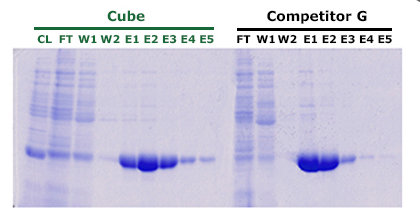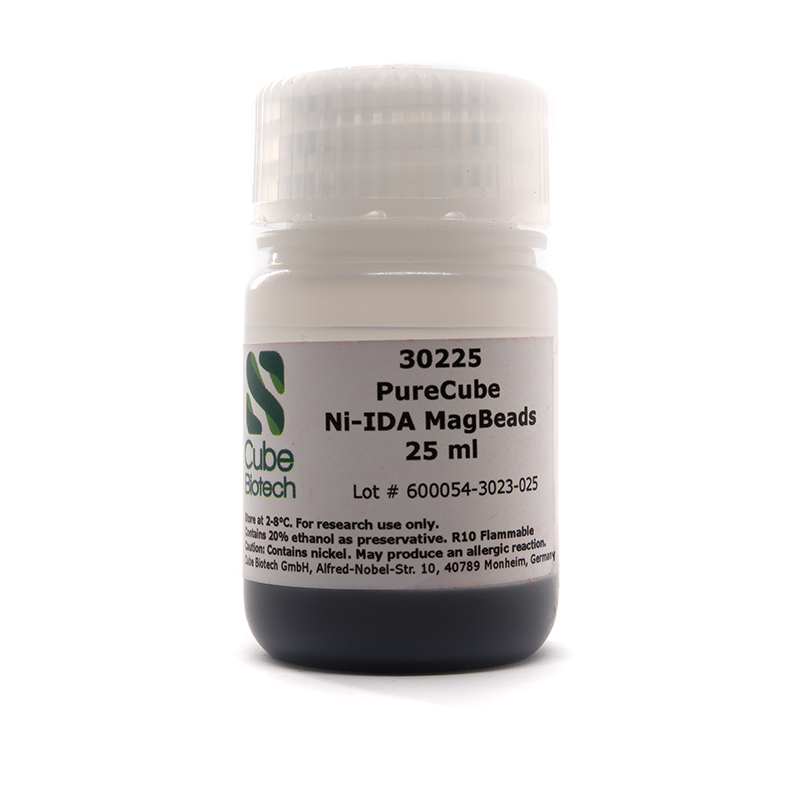PureCube Ni-IDA MagBeads
Order number: 30205
Description
PureCube Ni-IDA magnetic beads / MagBeads were developed by Cube Biotech for His-tag protein purification. Our year-long experience in manufacturing agarose resin lead to the high yield of 70 mg protein per ml resin, which is leading in the market compared to other Ni-IDA suppliers.
Ni-IDA products by Cube Biotech are also available as agarose resin beads for FPLC and batch spin or as XL magnetic beads for more viscous cell media. For your convenience Cube Biotech also offers its own MagBead separator for use with our magnetic beads.
Ni-IDA products by Cube Biotech are also available as agarose resin beads for FPLC and batch spin or as XL magnetic beads for more viscous cell media. For your convenience Cube Biotech also offers its own MagBead separator for use with our magnetic beads.
Datasheets
| Feature | |
|---|---|
| Usage | Specific binding and purification of 6x His-tagged proteins |
| Specificity | Affinity to His-tagged proteins |
| Binding capacity | >70 mg/mL |
| Bead Ligand | Ni-IDA |
| Bead size | 30 μm |
| Filling quantity | Delivered as a 25 % suspension |
| pH stability | 2-14 |
| Chelator stability | Stable in buffer containing 10 mM DTT and 1 mM EDTA |
| Other stabilities | 100% methanol, 100% ethanol, 8 M urea, 6 M guanidinium hydrochloride, 30% (v/v) acetonitrile |
Citations
| Purified Protein | Year | Author |
|---|---|---|
| Nanobody Proteins | 2023 | Möhrle R. |
Lab Results
Robust performance
Based on the same agarose matrix with high porosity and physical stability, PureCube Ni-IDA agarose exhibits a protein capacity of 50 mg protein per mL resin, which is competitive with that of products from market-leading providers. Figure 1 shows the SDS-PAGE analysis of 6-His chloramphenicol transferase (CAT) expressed in E. coli and purified on gravity flow columns filled with PureCUbe Ni-IDA Agarose or Competitor G Ni-Sepharose High-Performance resin. The amount of protein drawn down from the columns in 5 elution fractions was comparable for the two affinity resins (CL: cleared lysate; FT: flow-through; W1-2: wash fractions; E1-5: elution fractions). Table 1 compares additional parameters among PureCube Ni-IDA Agarose and two equivalent market-leading resins.
Based on the same agarose matrix with high porosity and physical stability, PureCube Ni-IDA agarose exhibits a protein capacity of 50 mg protein per mL resin, which is competitive with that of products from market-leading providers. Figure 1 shows the SDS-PAGE analysis of 6-His chloramphenicol transferase (CAT) expressed in E. coli and purified on gravity flow columns filled with PureCUbe Ni-IDA Agarose or Competitor G Ni-Sepharose High-Performance resin. The amount of protein drawn down from the columns in 5 elution fractions was comparable for the two affinity resins (CL: cleared lysate; FT: flow-through; W1-2: wash fractions; E1-5: elution fractions). Table 1 compares additional parameters among PureCube Ni-IDA Agarose and two equivalent market-leading resins.

| Competitor | Particle Size | Metal ion capacity | Binding capacity | pH stability | Recommended flow rate | DTT stability | EDTA stability |
|---|---|---|---|---|---|---|---|
| Cube Biotech | 32-60 µm | >25 µmol/mL/mL | 70 mg/mL | 3.0-13.0 | 0.5-2.0mL/min (6.0 mL/min possible) |
10 mM | 1.0 mM |
| Competitor G | average 90 µm | >30 µmol/mL | 15 mg/mL | 3.0-13.0 | 1.0 mL/min | No information | No information |
| Competitor S | 45-160 µm | 6-18 µmol/mL | 70 mg/mL | Not provided | 1.0 mL/min | 5 mM | Not recommended |
Video
Video Guide - How to use MagBeads
FAQ
Can I get the datasheet for the Ni-IDA MagBeads?
What are the reasons for non-specific binding?
There are some protein that can bind to Ni-IDA even without having a His-tag. But to a lesser extent. Washing with NaOH after elution of your protein of interest removes unspecific bound proteins from your resin.
I want to use a high concentration of EDTA and DTT. Is it possible to use Ni-IDA from Cube Biotech?
No, it is not recommended because nickel-ions are reduced with DTT or dissolved with EDTA. If you want to use high concentrations of EDTA and DTT you should use our INDIGO MagBeads.
How is the capacity at high flow rates?
If higher flow rates are desired we recommend using beads with bigger diameters. We offer Ni-IDA Magbeads with mean diameters of 30µm, and 90µm (XL).
With each size increase, the flow rates also increase due to the proportionally increasing space between the beads. However, the surface of the beads does not increase at the same speed as the diameter (square-cube-law). That results in decreasing amounts of purified protein per mL beads while increasing the bead sizes.
For 30µm we have average purification amounts of ~70 µg protein/mL beads. With 90 µm (XL) beads, this decreases to aroung 40 µg / mL.
We recommend reading the corresponding section of the "Introduction to agarose matrixes" guide on this subject for more detailed information.
With each size increase, the flow rates also increase due to the proportionally increasing space between the beads. However, the surface of the beads does not increase at the same speed as the diameter (square-cube-law). That results in decreasing amounts of purified protein per mL beads while increasing the bead sizes.
For 30µm we have average purification amounts of ~70 µg protein/mL beads. With 90 µm (XL) beads, this decreases to aroung 40 µg / mL.
We recommend reading the corresponding section of the "Introduction to agarose matrixes" guide on this subject for more detailed information.
After using DTT my resin changed color. How to regenerate it?
The DTT has probably destroyed your beads. Ni-IDA beads only have a very limited DTT tolerance. However, you can regenerate them to regain their functionality. Please read our detailed protocol for more information regarding this. It is linked above.
However, we would recommend using Ni-INDIGO products instead. They work with the same buffers and protocols as the Ni-NTA products but have a DTT tolerance of 20 mM.
However, we would recommend using Ni-INDIGO products instead. They work with the same buffers and protocols as the Ni-NTA products but have a DTT tolerance of 20 mM.



